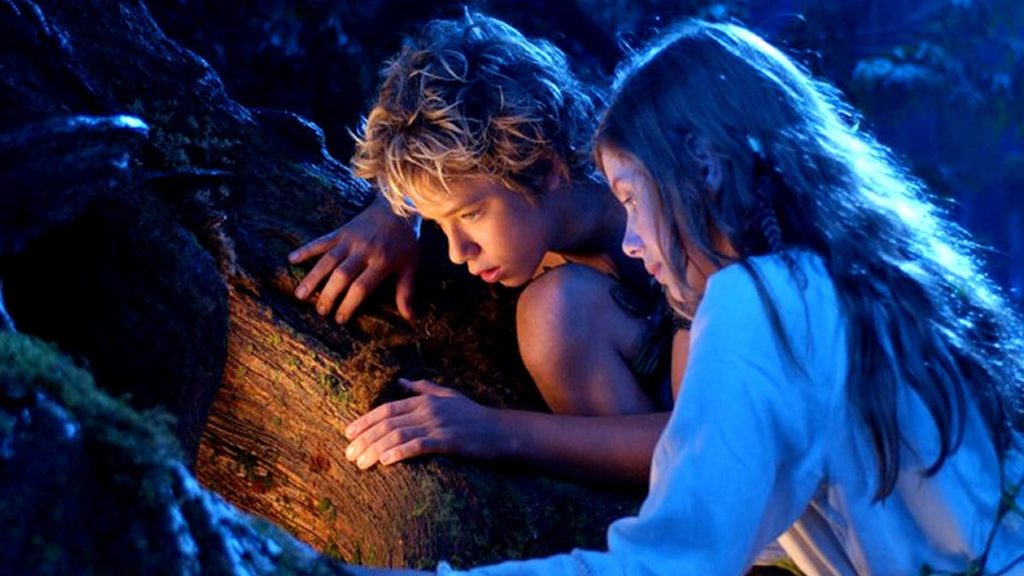
Growing up. Is it an adventure and a privilege, or a universally endured terminal illness? For young Peter Pan, it’s the latter. He enjoys flitting about in Neverland, frustrating evil pirates and heading the Lost Boys—a gang of orphaned lads who look like they just stepped out of a Disney version of Lord of the Flies. The thought of “maturing” is as nasty as cod liver oil to him. But Peter is restless. With his fairy friend Tinkerbell, he traverses the cosmos to visit the London home of the Darling family. He loves covertly listening to stories spun by the eldest daughter, Wendy, and wants nothing more than to have her return to Neverland with him.
A preadolescent herself, Wendy is on the verge of womanhood. Her younger years were spent playing with dolls and conjuring up breathtaking adventures that kept her two younger brothers, Michael and John, spellbound. Now her banker father has laid down the law: This is her last night in the nursery. It’s time to grow up. Unsure of what lies ahead, she is primed to accept Peter’s offer of eternal youth when he introduces himself and proceeds to whisk her and her brothers off to an island fantasy.
Tinkerbell is awfully sweet on Peter, though, and views Wendy as a rival. Her jealousy becomes one source of conflict in the film. And an even greater, more fearsome foe awaits in Captain Hook who, with his band of bloodthirsty pirates, wants to see Peter writhing on the end of his trusty blade. So Peter and Wendy flirt, dance among the fairies and innocently test the waters of first romance until inevitable, wicked forces get in the way. In the end, Wendy must decide if staying young forever is worth the cost of never seeing her parents again, and never knowing the thrill of growing older.
Central themes include recognizing the advantages of growing up, assuming one’s place in adult society, and embracing family relationships. There’s a wonderful moment early when the children express disappointment in their father’s lack of swashbuckling heroism, only to have their mother extol his character. She says he sacrifices for the family, has put aside his own dreams in order to provide for them, and exhibits “the bravery of thinking of others before oneself. … That is why he is brave.”
When Wendy notices Peter crying, she naturally assumes it’s because he has no mother. Life in Neverland loses its luster as Wendy realizes, “We have forgotten our parents. We must leave at once before we are forgotten!” It reminds her of the value of her mother and father. Back in London, all of the Lost Boys are overjoyed to be included in a family—except Peter Pan. Peter’s stubborn refusal to grow up (“You can’t catch me and make me a man!”) ends with him staring into the window at the happy throng as an adult Wendy intones, “He was looking at the one joy from which he would be forever barred.”
As sweet as Peter and Wendy’s childish flirtations are, it’s obvious that any romance that stagnates in youth can’t be entirely satisfying. Wendy questions Peter about his feelings of “love,” a word that runs his blood cold. Like many males in the real world content to “play at love” while their partners long for something more, Peter doesn’t appreciate the sacrificial nature of it, nor does he want to be tied down by any kind of commitment. If love means growing up, he wants no part of it. Wendy believes there’s more to it than no-strings frivolity. Despite her jealousy, Tinkerbell has the deeper understanding of love when she lays down her life to keep Peter from unknowingly drinking the poison (read John 15:13 and 1 Cor. 13 for biblical insight). Many characters race to one another’s aid and put themselves in harm’s way for their friends.
Wendy, in her role as a pirate, refuses to steal (“I could not be expected to pillage”). She also expresses a partiality for stories in which good triumphs over evil. So goes this story as family and friendship triumph over darkness, and a young man’s belligerent refusal to grow up and love sacrificially bears the consequence of lonely independence. Peter Pan celebrates the natural order of life with all of its duties and pleasures.
When a teddy bear gets decapitated in battle, an Indian woman chants on its behalf (“She is calling forth the spirit of the eagle to heal the warrior”). Symbols of goodness (a halo) and malice (devil horns) pop up on the voiceless Tinkerbell to convey her extreme emotions.
Although the average 12-year-old certainly has eyes for the opposite sex, undercurrents of sexual tension between Peter and Wendy may be a spoiler for parents of younger children. There’s nothing blatantly sexual here, but the subtle acknowledgements of budding hormones are unmistakable. Pan is very selfish and possessive of Wendy (he whispers as he watches her mother pining, “We can’t both have her, lady”), and takes a controlling tone with her. A stern schoolmarm overreacts to a picture Wendy draws of a winged boy hovering over her bed. A “hidden kiss” is deemed “the greatest adventure of all,” and appears to be reserved for one special person. Peter and Wendy kiss. John glows red after getting a smooch from an Indian squaw. There’s a brief shot of boys’ bare backsides.
The tone is darker and the violence more intense than fans of the 1951 Disney cartoon might expect. And the mermaids are a far cry from Ariel—creepy, malevolent sirens bent on drowning Wendy. Director/screenwriter P.J. Hogan told Plugged In that his team wanted their Captain Hook to be “genuinely scary,” not like the comical Disney cartoon or Dustin Hoffman’s witty villain in Steven Spielberg’s Hook. Revealing a jet-black heart, this Hook nonchalantly murders people, as well as an innocent fairy. He is harsh with the children and obsessed with killing Peter. Incompetent crewmen face immediate and fatal consequences from Hook. Two are shot dead with a pistol. Another gets blasted with a rifle. Yet another is stabbed with his hook.
Sword fights are intense. One ends with a pirate blasting the weapon out of Wendy’s hand. Hook kicks Peter, head-butts him and slams him to the deck. Two pirates lunge at the children from opposite sides and wind up stabbing each other in the chest when the kids duck. Pan crosses swords with Wendy and briefly holds a blade to her throat. The ticking crocodile is an enormous, frightening CGI creation that chases Hook before eventually swallowing him whole. Pirates fire cannonballs at the children. Peter wrestles with his shadow. On Tinkerbell’s signal, the Lost Boys shoot arrows at an airborne Wendy, causing her to crash. Men are bowled over by a large dog. Captain Hook’s first mate, Smee, shoots a fellow pirate dead. Hook smashes a pocket watch in a fit of anger. Awakened by a peg-legged parrot’s squawking, Smee fires his pistols at the bird. Tinkerbell batters Wendy’s head against a bedpost and grabs her hair.
None.
Smee offers Wendy rum and cigars (she declines). When Peter, acting in the role of father to the Lost Boys, suggests that he should kill the children for being bad, Wendy counters with the idea of forcing them to take nasty-tasting medicine instead. Hook tries to poison Peter with a mix of “malice, jealousy and disappointment” distilled into a deadly serum. Grownups drink alcohol in one scene.
John swipes a man’s top hat while flying through the streets of London (a theft treated playfully and without consequence). Eerie moments include skeletal remains of dead prisoners chained to rocks. Children are kidnapped, bound, gagged and left to drown in a rising tide. A child spits at Captain Hook. With a sly tone, Peter says, “To die would be an awfully big adventure” which, for some viewers, could romanticize checking out early.
In an attempt to breathe added dimension into the well-known children’s story by J.M. Barrie, this live-action Peter Pan is fun, action-packed and smart-looking, if a bit misguided. Oh, sure, it puts a premium on family. It reminds young and old alike that growing up, while difficult at times, is an adventure not to be missed. There are plenty of positive messages. Yet parents may feel it’s inappropriate for the target audience. Aimed at grade-school children, Peter Pan is darker and more violent than many families of 5- to 10-year-olds would prefer. There’s also a subtle sexual subtext that may generate questions from little ones that force Mom and Dad to discuss issues of puberty and first love before they’re ready. These drawbacks aren’t inherently a problem for adolescents, though. In fact, for young people preparing to make the leap into puberty, the film is a vehicle that—with proper parental input—could make the transition smoother.
